
* The B-29 led to an improved series, the "B-50", which was built in smaller numbers, serving most prominently as a tanker. The B-29 also led to a transport derivative, the "C-97 Stratofreighter", which was mostly built as an inflight refueling tanker, the "KC-97 Stratotanker", with some also built as commercial "Stratocruiser" airliners.
* At the end of World War II, work was underway on a significantly improved model of the B-29, the "Model 345-2", originally designated the "B-29D". This variant featured general improvements, such as:
Although the overall configuration of the new variant was generally like that of its predecessors -- same defensive armament, same dual bomb bays, and so on -- there were substantial alterations in systems, to the point where the new variant had only about 25% of parts in common with its predecessors.
A B-29A was provided to Pratt & Whitney for a prototype fit of the Wasp Majors, with this machine designated "XB-44". Trials were successful and orders were placed for 200 B-29Ds, but the end of the war in the Pacific put the program at risk. Since Congress was reluctant to approve production of old aircraft at the time, the B-29D was given the new designation of "B-50A" in order to sell it as a "new" aircraft, and an initial batch of 50 was ordered. The B-50 was seen as an interim solution for the strategic bombing role until more formidable bombers were available.
First flight of a production B-50A was on 25 June 1947, with initial service deliveries a year later. Empty weight and top speed were increased by about 10%. A total of 80 B-50As was built into 1949, with 57 modified to use the clumsy snag-hose inflight refueling scheme of the KB-29M. One B-50A fitted up for inflight refueling, LUCKY LADY II, performed the first nonstop round-the-world flight, from 26 February to 2 March 1949. Total flight time was 94 hours, the B-50A being refueled four times by KB-29Ms.
The B-50A was followed by the "B-50B", with initial flight on 14 January 1949 -- by which time the USAAF had become an independent service, the US Air Force (USAF). The B-50B looked the same as the B-50A externally, but had a range of internal improvements, notably a lighter fuel tank system. 45 were built, one being retained for trials as the "EB-50B" -- experimental fits including bicycle landing gear, and a dubious tracked landing gear system.
The other 44 were immediately converted to the reconnaissance role and redesignated "RB-50B". They had four camera stations, with a total of nine cameras, plus weather observation instruments, the additional crew needed to handle the reconnaissance systems operating in a capsule installed in the rear bomb bay. They could use the snag-hose refueling system, and also could be fitted with a 2,653-liter (700 US gallon) external tank under each wing, increasing the fuel supply by about 15%. They retained all defensive armament. From 1951, the RB-50Bs were further updated to new reconnaissance configurations:
There was talk of a "B-50C", which mutated into the "B-54", the primary improvement being "turbo-compound" Wasp Major engines -- which had exhaust-driven turbines that fed power into the engine driveshaft. It also had extensive airframe changes, including a wider wingspan that required outrigger landing gear. On consideration, the B-54 promised to be expensive -- it implied widening airstrips to handle the outrigger landing gear -- and not particularly rewarding, the turbojet clearly being the future for combat aircraft. The story of the B-54 is complicated, but it has a simple ending: no B-54s were ever built.
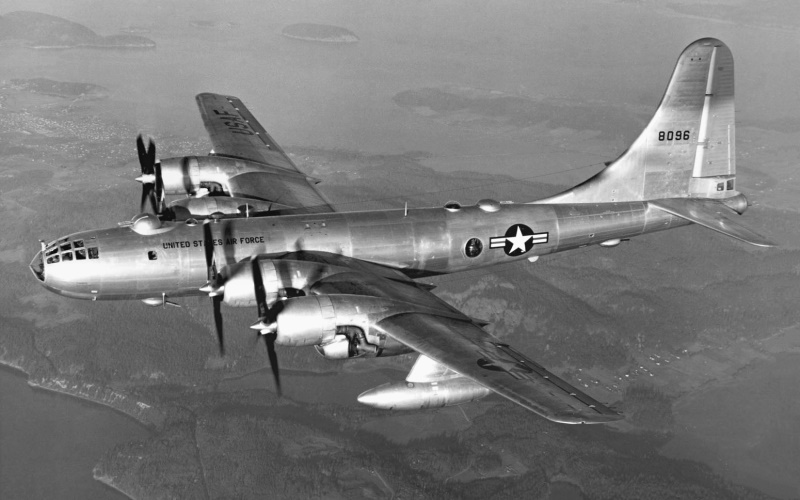
That meant the next version was the "B-50D", which featured general refinements, the most visible being simplified nose glazing. The B-50D could be fitted with the underwing fuel tanks, and had an improved AN/APW-24 bombing-navigation system. From the 16th B-50D, production was kitted for boom refueling. Later production also had a distinctive faired-back forward dorsal turret.
The B-50D went into service with the USAF Strategic Air Command in 1949, with 222 built to the end of 1950 -- more than all the other B-50 variants. The type suffered painful teething problems early on, but they were generally ironed out. However, the AN/APW-24 system proved chronically unreliable, and the bomb bays of the B-50D fleet had to be continually updated to handle new types of nuclear weapons.
The last 24 B-50Ds on order were actually completed as "TB-50H" crew trainers, fitted out with Boeing B-47 avionics for crew conversion training. In addition, 11 B-50As were converted to "TB-50A" crew trainers, while 11 B-50Ds were similarly converted to "TB-50D" crew trainers; these machines had nothing in particular to do with the B-47.
The last Superfortress built, a TB-50H, was delivered in March 1953. That gave B-50 production as 80 B-50As, 45 B-50Bs, 222 B-50Ds, and 24 TB-50Hs; or 371 machines, less than a tenth the number of B-29s, and a total of 4,331 Superfortresses in all. The B-50 was never really more than a stopgap to fill the strategic reconnaissance and nuclear bombing roles, until jet bombers could step up to the job. Reserved for the strategic role, the B-50 never dropped bombs in Korea.
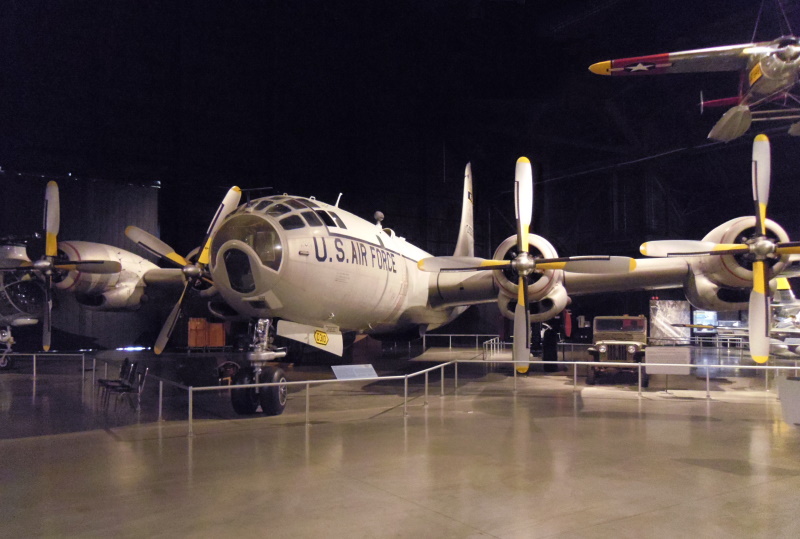
* There were, of course, a number of conversions and special versions of the B-50. From the mid-1950s, 36 B-50Ds were converted to a weather reconnaissance configuration, to be redesignated "WB-50D". Along with their weather instruments and fallout-sampling systems, they also had an auxiliary fuel tank in the bomb bay.
Unfortunately, they were not given a service-life extension when they were updated -- military aircraft had shorter life-cycles than they do now, and the Air Force didn't think as much in terms of methodical service-life extension programs. The WB-50Ds were troublesome to keep flying, and suffered from a high accident rate, the difficulties aggravated by the fact that WB-29 pilots moving to the WB-50D didn't necessarily appreciate that the two aircraft had some dangerously different handling characteristics.
The B-50 was also used as a tanker, with machines retired from the bomber role stripped of defensive armament, given outer wing reinforcement, and fitted for triple-point hose-drogue refueling to support Tactical Air Command fighters -- with a centerline hose-drogue refueling station, and a hose-drogue unit (HDU) pod near each wingtip. TAC fighters didn't need the high fuel flow rates of the boom system, but they did need triple-point refueling to handle multiple fighters simultaneously.
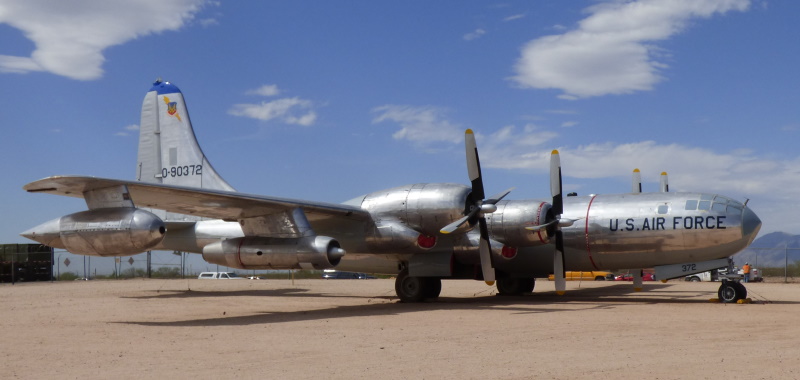
The B-50 tankers also featured the wing external fuel tanks -- well inboard of the HDUs -- and had bomb bay fuel tanks, as well as observation blisters along the rear fuselage, the tail turret being replaced by a spindle fairing. A total of 120 B-50As, B-50Bs, B-50Ds, and TB-50Hs were converted, being redesignated "KB-50". They entered service from 1956, replacing weary KB-29s, and flying support USAF Tactical Air Command fighters. They also weren't given a service-life update and were troublesome to keep flying.
Since the KB-50 was so much slower than the fighters it was supposed to refuel, a GE J47-GE-23 turbojet engine with 23.1 kN (2,359 kgp / 5,200 lbf) thrust was fitted outboard on each wing, replacing the underwing fuel tanks, to provide for boost speed, as well as additional take-off power. The addition of the turbojets required the installation of a second fuel system, since the four piston engines used aviation gasoline, while the turbojets used kerosene-line jet fuel. All the KB-50s were updated, to be redesignated "KB-50J". All 24 TB-50Hs were converted to the same configuration and redesignated "KB-50K". No B-50s were converted to boom refueling tankers, even on an experimental basis.
As with the B-29, the B-50 was used to carry experimental rocket planes like the Bell X-1 and X-2 -- which was hazardous, two "EB-50As" being lost in accidents when the rocket plane caught on fire or exploded. There were a number of other test and trials conversions, including the EB-50B mentioned above, and a "DB-50D", which was a B-50D used for trials of the ill-fated Bell "XGAM-63 Rascal" nuclear stand-off missile, with first launch of a Rascal from the DB-50D in 1952. Two other B-50s were used as trials platforms for the "X-9 Shrike", which was a scaled-down Rascal, used to test subsystems. Although a set of Boeing B-47s were earmarked as Rascal carriers, the program was soon rendered obsolete by improvements in missile technology, and canceled in 1958.
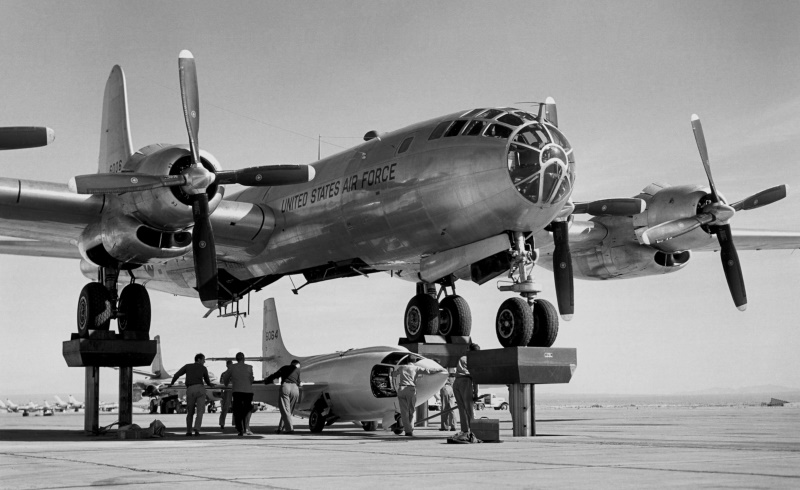
* The B-50D was phased out of bomber service in 1955. RB-50s were used as snoopers to spy on Red installations during the Cold War, with a number of them shot down -- the crews typically being lost. There were rumors, never confirmed and likely myths, that the Soviets did take some survivors prisoner and interrogated them, with the prisoners either being executed or dying in captivity.
WB-50Ds and KB-50s lingered into the 1960s, with WB-50Ds performing weather observations during the Cuban Missile Crisis in 1951, and some weary KB-50s flying in the early years of the war in Vietnam in support of tactical fighters. They were replaced by the Boeing KC-135, with both the WB-50Ds and KB-50s withdrawn in 1965, The last flight of a B-50, a machine used for trials as the "JB-50D", was in 1967. This machine now resides at the USAF Museum, in the form of a WB-50D.
BACK_TO_TOP* Design studies for what would end up being a transport derivative of the B-29, the Boeing "Model 367", began in 1942. The immediate focus of the effort was sales to the military, but the company was also looking down the road towards selling civilian airliners in the postwar period. The Model 367 employed the same wings, engines, tail, and so on -- with a new "double-bubble" pressurized fuselage that mounted an expanded top fuselage section on top of the lower section of the old B-29 fuselage.
The upper section of the fuselage had a diameter of 3.5 meters (11 feet 6 inches), while the lower section had a diameter of 2.9 meters (9 feet 6 inches). The two decks were separated by the floor of the upper section, the upper section having a volume of 283 cubic meters (10,000 cubic feet). The sections would be pressurized.
Boeing officials showed off the preliminary design of the Model 367 to Navy and USAAF officials in the summer of 1942; the Navy had no need for such a large transport, but the USAAF was interested, with officials asking for a refined design. After further development, the USAAF awarded Boeing a contract for three "XC-97" prototypes in January 1943. A mockup was available for inspection in March.
The mockup added a new feature, in the form of rear clamshell doors to allow loading up a dual tail ramp, deployed by an overhead crane, which could then be used for handling cargo. Trucks could also back up to the tail for unloading or loading. The standard military cargo hauler of the time, the Douglas C-47, had a side door, making loading of large cargoes cumbersome. Government officials liked the idea, with the prototypes to be built with the rear doors.
Alas, with Boeing forced to concentrate on production of the B-17 and B-29, the C-97 program was a second priority, and the initial flight of the first prototype wasn't until 9 November 1944. Under the circumstances, it was a bit surprising that it took place as soon as it did. Powerplants were originally Wright R-3350-23 Duplex Cyclones with 1,640 kW (2,200 HP) each, which were later updated to R-3350-57A engines with 1,735 kW (2,325 HP) each. Performance was excellent, the first prototype flying across the country on 9 January 1945 to Washington DC in a little over six hours, average speed being 616 KPH (383 MPH). Favorable tailwinds helped.
In July 1945, shortly before the end of the war, the USAAF ordered ten evaluation machines:
The military found the YC-97A interesting. One of the three evaluation machines was retained by Boeing as an engineering test machine; the USAF used another of the three during 1949 in the closing phases of the Berlin Airlift, hauling coal into the isolated city. The YC-97A having proved all that was hoped for it, the Air Force went on to order what would become a total of 50 production "C-97A Stratofreighter" cargo haulers, with initial delivery on 15 October 1949.
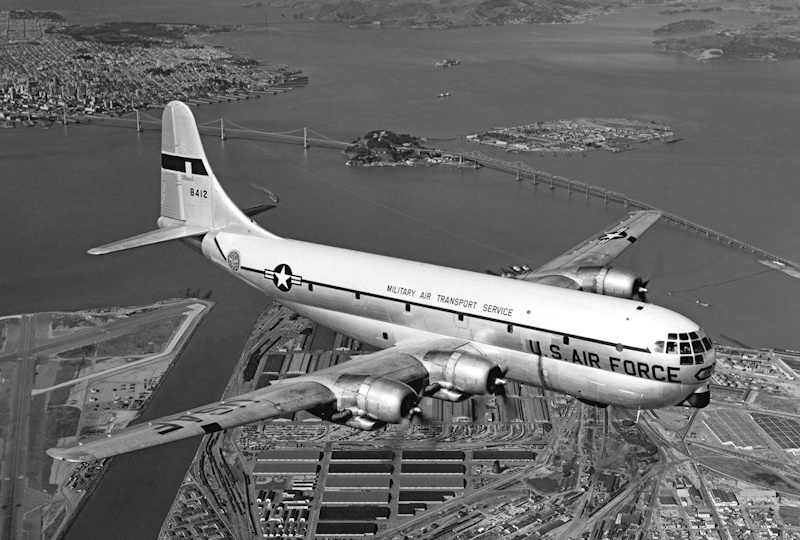
The ultimate fate of the XC-97 machines is unclear, while the YC-97s were put into line service, to be ultimately retired and scrapped. Of the three YC-97A machines, two were upgraded to production C-97A specification, while one was retained by Boeing as a test machine. This YC-87A, nicknamed the "Shrimp Boat" for some reason, remained in service to 1965, being then retired and ultimately scrapped. The single YC-97B remained in formal service as the "C-97B" -- later "C-97D", see below -- into the late 1960s, to ultimately be scrapped.
BACK_TO_TOP* The C-97A was effectively a B-50 with a cargo-hauler fuselage, being powered by P&W R-4360-26 Wasp Majors with 2,425 kW (3,250 HP) each, driving four-bladed variable-pitch Hamilton Standard hydromatic propellers. Fuel capacity was 26,670 liters (7,036 US gallons), stored in nylon bladder cells in the wing center section and outer wings.
Flight surface and landing gear arrangement were effectively identical to those of the B-50, all gear having twin wheels, the main gear retracting forward into the inboard engine nacelles, the nose gear retracting backwards. They had the hydraulically-actuated bumper under the tail. They featured the clamshell rear loading doors. They also had two doors into the lower deck on the left side of the fuselage, one forward and one rear, both in the configuration of drop-down "airstairs". Later C-97A production had a hinge-up cargo door on the forward right side of the fuselage, loaded via a forklift.
The overhead hoist system was modified to help with paradropping cargoes. The C-97A visibly differed from the YC-97A by the introduction of a distinctive "chin" radome for AN/APS-42 weather / navigation radar -- it was one of the first transport aircraft to be fitted with weather radar from the outset. The C-97A had a useful payload of 16,000 kilograms (35,000 pounds), and could haul up to 134 troops. It could alternatively carry two trucks, towed artillery, or light tracked vehicles on the upper deck, with a number of personnel carried on the lower deck; and could also be configured for medical evacuation, with up to 83 litters, 4 attendants, and emergency medical facilities.
The 50 C-97As were followed by 14 "C-97C" Stratofreighters, all delivered in 1951. They were externally the same as the C-97A, but had minor improvements, such as a reinforced cargo floor. They were all delivered in medical evacuation configuration, joining C-97As in airlifting casualties back from Korea.
A total of 77 Stratofreighters, including prototypes, was built in all. There were a number of modifications / special variants of the Stratofreighters:
* The C-97 was clearly useful as a transport, but the Air Force ended up having much more interest in it as a tanker. Three C-97As were used to evaluate carriage of a modular boom-refueling unit that plugged neatly into the opening for the rear cargo doors, these machines being redesignated "KC-97A". Trials proving successful, they reverted to C-97As after trials were completed.
The KC-97As led to production "KC-97E Stratotankers", featuring the boom refueling system and four fuel tanks on the upper deck, the four proving a total fuel capacity of 27,290 liters (7,200 US gallons). They could be converted back to a cargo configuration by yanking the boom refueling module and the upper-deck fuel tanks. They were powered by uprated R-4360-35C Wasp Majors with 2,610 kW (3,500 HP) each.
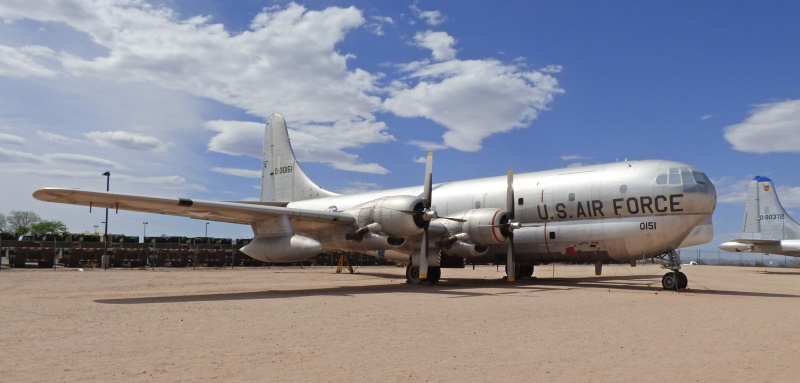
60 KC-97Es were delivered in 1951:1952, being followed by 159 "KC-97F" Stratotankers up to the end of 1953. They were generally identical to the KC-97E, except for R-4360-59B engines -- with same power ratings, but technical improvements. They were followed in turn by the definitive "KC-97G", the primary changes being:
A total of 592 KC-97Gs was built, the last in 1956, ending C-97 production, with a total of 811 Stratotankers built. The Stratotanker gave the USAF Strategic Air Command truly global reach. From 16 to 18 February 1957, three Boeing B-52Bs performed a nonstop round-the-world flight as a demonstration of SAC power, being supported by roughly 100 Stratotankers. The flight took 46 hours.
___________________________________________________________________ BOEING KC-97G STRATOTANKER: ___________________________________________________________________ wingspan 43.1 meters (141 feet 3 inches) wing area 164.34 sq_meters (1,769 sq_feet) length (no boom) 35.8 meters (117 feet 5 inches) height 11.7 meters (38 feet 3 inches) empty weight 37,420 kilograms (82,500 pounds) max loaded weight 79,500 kilograms (175,000 pounds) max speed at altitude 645 KPH (400 MPH / 350 KT) cruise speed 565 KPH (350 MPH / 305 KT) service ceiling 9,150 meters (30,000 feet) range 6,925 kilometers (4,300 MI / 3,740 NMI) ___________________________________________________________________
However, the low speed of the KC-97G made refueling increasingly fast jets difficult, as they had to slow down to near their stall speed. Aircrews came up with a scheme known as "tobogganing" to increase speed during refuelings, with both the tanker and the jet starting out at high altitude and conduct the operation as both fell "downhill" to lower altitude.
That was a clumsy scheme, and so one KC-97G was fitted, as per the KB-50J/K, with a J47-GE-23 turbojet under each outer wing for refueling operations and take-off boost. This test machine was designated "JKC-97G". The scheme proved satisfactory, with this aircraft then becoming an operational "KC-97L", with 80 more conversions. It appears that at least some of the J47s were scavenged from retired KB-50Ds; some sources hint that the underwing HDUs were transplanted as well.
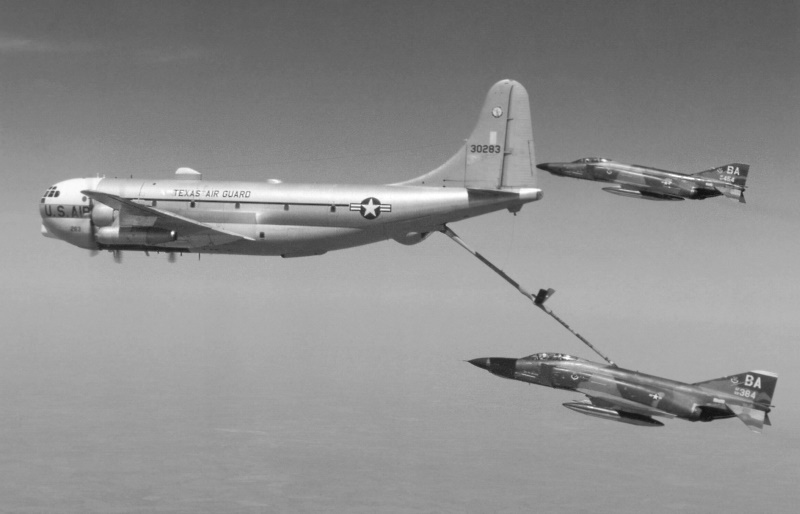
The KC-97 was gradually replaced in tanker service by the next-generation Boeing KC-135 tanker -- the last KC-97G, incidentally, was rolled out on the same day as the first KC-135. However, they were not out of business by any means, with the tankers stripped of inflight refueling gear to become "C-97E", "C-97F", and "C-97G" cargo haulers. A total of 27 KC-97Gs was converted to personnel transports, like the C-97D, under the designation of "C-97K", while 22 were used for search and rescue, being designated "HC-97G". Five parked KC-97Gs were used as ground instruction airframes, under the designation of "GKC-97G".
One KC-97F was fitted out for hose-drogue refueling with a centerline station, being redesignated "KC-97H"; the conclusion was that mission should be left to the KB-50. Two KC-97Gs were modified in the late 1950s to the experimental "KC-97J" configuration, with four YT43-P-5 turboprops, providing 4,250 kW (5,700 HP) each. Performance was significantly enhanced, but with the jet age, the Stratotanker was old news, and it didn't make sense to re-engine the C-97 fleet with turboprops -- but the idea would be seen again.
One of the more confusing missions of the C-97 series was as spyplane. In the early 1950s, the USAF set up a special program office codenamed BIG SAFARI, which had a focus on fast-track special conversions of aircraft for intelligence gathering. During the Cold War, Berlin was isolated in East Germany, accessible via one ground and three air corridors. The air corridors provided an opportunity to perform surveillance of East German territory -- but it had to be done discreetly, lest the Soviets object.
A very big long-range optical (LOROP) camera named the "K-42" AKA "Boston camera" had been developed, said to be the biggest airborne camera ever made. It was supposed to have been carried by a Convair B-36 bomber, but the oversized B-36 would have been decidedly indiscreet in the role. The C-97 was seen as ideal, being big enough to carry the oversized camera, while not attracting any attention to itself.
One of the YC-97As was fitted with the K-42 camera, hidden behind discreet doors when not in use, the aircraft not being given any special markings. It was also fitted with an array of smaller cameras. It only ran the Berlin route for about six weeks; its lower-powered engines were unsatisfactory, and so in 1953, one of the KC-97As used to evaluate the boom refueling system was fitted with the camera system instead, with the refueling unit removed. The PIE FACE aircraft remained in service to 1962, being given repeated upgrades.
Incidentally, of course the Soviets suspected the Americans were likely spying on them from the air corridors, if they didn't know it for a fact, and restricted altitude along the three routes to below 3,050 meters (10,000 feet). It doesn't appear the Soviets ever complained about PIE FACE, and in fact may have found the surveillance useful on occasion, as a way of showing their hand to the Americans.
From 1961, BIG SAFARI converted eight KC-97Gs to intelligence-gathering platforms, no two being exactly alike, in fact most of them changing configuration considerably over time. Some were used for photographic intelligence, some for ELINT, some for both. Sources occasionally refer to them under the designation of "EC-97G", but it is unclear that they ever "broke cover" with a special designation. They served all over the world, including in the Vietnam War.
* The last C-97s were phased out of US military service in the 1970s. The most direct replacement for the type was the Lockheed C-130 Hercules. Interestingly, the Air National Guard operated KC-97Gs through the 1960s, using them for tactical aircraft support. In the 1960s and 1970s, the Israelis obtained a KC-97G and eight KC-97Ls; they weren't used for boom refueling, since the Israelis don't use the boom system, but a few were apparently fitted with a KB-50-type HDU pod under each wing. The Israelis also used them for surveillance, ELINT, and electronic warfare, one being shot down by an Egyptian surface-to-air missile in 1971.
The Spanish Air Force obtained three KC-97Ls -- plus two spares hulks -- in the 1970s, to provide tanker support for their McDonnell F-4C Phantoms. Some retired C-97s were sold to civilian users, to be used as cargo haulers and air tankers for fighting forest fires. A number are on static display -- with some fitted up as restaurants or such -- and one C-97G, named ANGEL OF DELIVERANCE, is still flying, in the service of the Berlin Airlift Historical Foundation. It is painted up as the YC-97A used to haul coal during the Berlin Airlift.
BACK_TO_TOP* Boeing also built 56 "Model 377 Stratocruiser" airliners for commercial service, the first flying on 8 July 1947, with the single YC-97B being a lightly militarized version of the airliner.
Five airlines flew new-production Stratocruisers: Pan Am, American Overseas Airlines, United, Northwest, and BOAC. Some were also obtained by Scandinavian Airlines System, but these machines ended up in BOAC hands before they entered service. American Overseas Airlines was bought out by Pan Am, with the Stratocruisers acquired then going into Pan Am service.
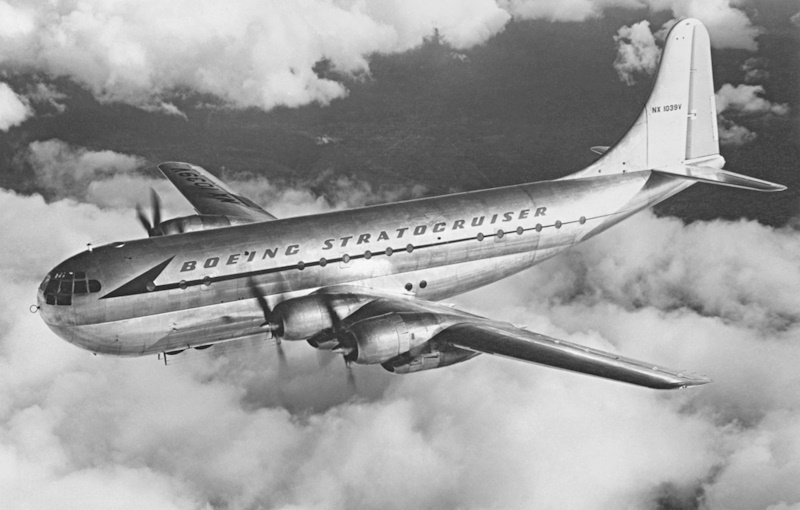
All these machines lacked the rear cargo doors, and had an upper-deck passenger door on the rear left fuselage. There were two service doors, one fore and one aft of the wing, into the lower deck on the right side of the fuselage, with a smaller galley-service door in the tail; it had to be loaded via forklift. Window arrangements varied considerably, most users having round windows, a few with square windows, along with different numbers and locations of windows.
A luxury configuration had 48 day or 24 sleeper seats; high-density configurations had 100 seats, though 86 was more the norm. Some had luxuries such as a lounge and cocktail bar on the lower deck. They were regarded as a high-class ride, but the accident rate was high, partly due to the temperamental Wasp Major engines. They were reaching the point of diminishing returns for piston propulsion, and were not noted for reliability.
56 Stratocruisers were built, including a prototype retained by Boeing, giving total production of the C-97 family as 77 + 811 + 56 == 944. The Stratocruiser did turn a profit, but only as a sideline to military sales. Boeing considered a stretched derivative of the Stratocruiser with turboprop engines, extended wings, and underwing fuel tanks -- but by that time the jet age was arriving, and the concept was a nonstarter. Other concepts such a Stratocruiser with mildly-swept wings and dual turbojets on a pylon under each wing were never more than fantasies.
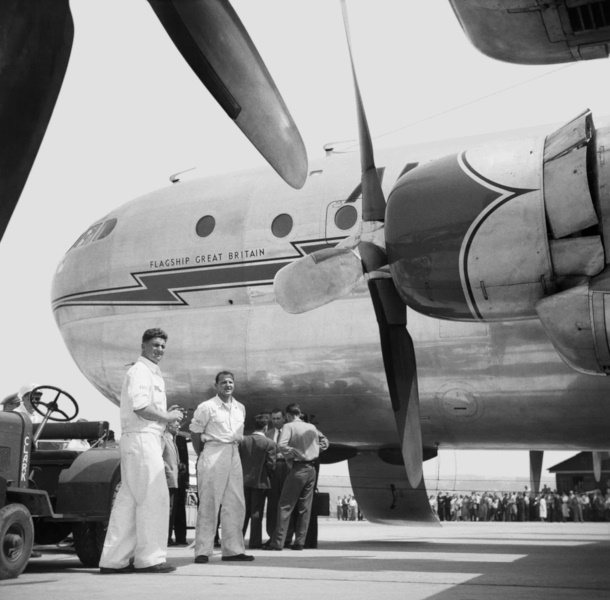
The Stratocruisers remained in first-line service to the end of the 1950s, then being sold off to second-string operators. They were generally operated as cargo haulers, being fitted with C-97A-style side cargo doors; of five obtained by the Israelis for military use, two were even given "swing tails" for rear cargo loading. The Stratocruisers lingered in service to the 1980s.
* The C-97 series, including the Stratocruisers, played a highly visible role in the Space Age. John M. "Jack" Conroy had flown bombers and transports for the USAAF, doing some time in a German POW camp; in the 1950s, he flew as an airliner pilot, also flying KC-97s with the Air National Guard.
In the early 1960s, the US National Aeronautics & Space Administration (NASA) had a problem with porting rocket stages across country. They were too big to go by road or rail, and so they only option was to haul them via barge through the Panama Canal, which was of course troublesome and time-consuming. Conroy sensed an opportunity, thinking C-97s could be rebuilt with a high-capacity fuselage to fly the big loads across country. An aircraft broker named Lee Mansdorf -- who lived in Van Nuys, California, as did Conroy -- had obtained a number of C-97 airframes, so Conroy had access to the raw materials.
NASA was skeptical, but the agency's famous Dr. Wernher von Braun supported wind tunnel tests that showed the idea was feasible. Conroy then directed the reconstruction of a Stratocruiser, giving it a stretch of 5.08 meters (16 feet 8 inches), and a rebuilt upper fuselage capable of accommodating rocket stages with a diameter of 6.02 meters (16 feet 9 inches). The rear fuselage could be pulled off aft of the wing for loading. The tailfin featured a large forward fillet to keep the aircraft flying straight. The machine had to be worked on in the open, there being no hangar big enough at the Van Nuys Airport for it. A NASA staffer named it the "Pregnant Guppy", and the name stuck.
Initial flight was on 19 September 1962. Handling proved surprisingly good; while taking von Braun for a ride on the prototype, Conroy shut down two engines, with von Braun not noticing anything unusual until Conroy pointed to the feathered propellers. Conroy's Aero Spacelines obtained a government contract to haul NASA rocket stages in 1963 -- much to Conroy's relief, since he'd mortgaged his home to fund the aircraft's development.
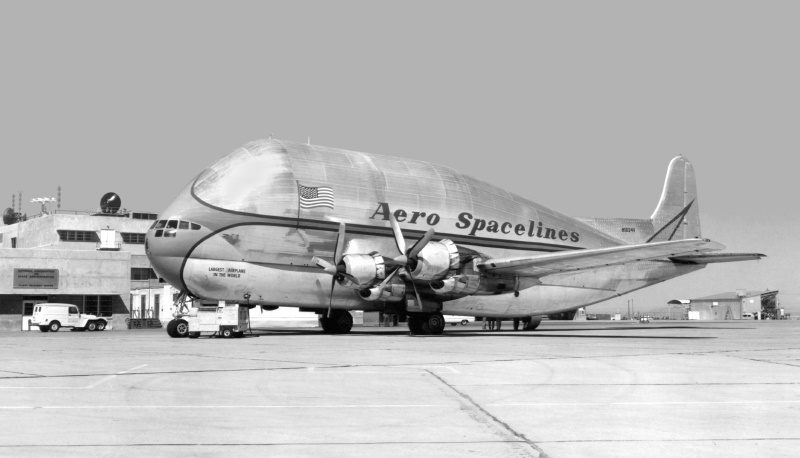
The Pregnant Guppy wasn't adequate to do the job, so Conroy built up a more ambitious "Super Guppy", derived from a C-97J. It featured:
Initial flight was on 31 August 1965. At the time, the Super Guppy was the world's biggest aircraft in terms of internal volume. The Super Guppy was eventually purchased by NASA to support the space shuttle program.
Conroy also put together what was named the "Mini-Guppy", intended to haul more compact payloads, the hold being able to accommodate cargoes up to 5.5 meters (18 feet) in diameter. Apparently Conroy wanted to diversify out of the space market, with the Mini-Guppy to haul, for example, oilfield gear. It had a swing tail for loading. The Mini-Guppy performed its initial flight on 24 May 1967. Aero Spacelines ran into financial trouble in that year and was bought out, to ultimately end up in the hands of Tracor Aviation.
Conroy stayed with Aero Spacelines after the buyout, but only for a number of months. He then his own company, named Conroy Aircraft, mostly focused on turboprop conversions of older aircraft, and was officially out of the Guppy business. His later business efforts were not highly successful; he died in 1979 at age 58.
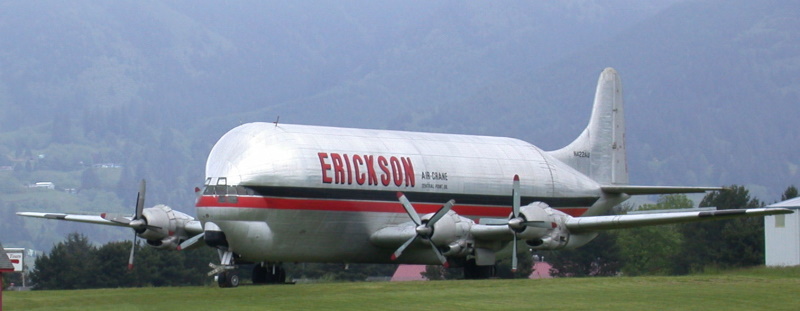
Aero Spacelines, sans Conroy, put together a "Mini-Guppy Turbine" AKA "Guppy 101" -- with a swing nose and Allison 501-D22C turboprops providing 3,665 kW (4,912 SHP) each, the Allison 501 being a civil version of the well-known military T56 turboprop. The aircraft performed its initial flight on 13 March 1970, but was lost in a take-off accident on 12 May, all four crew being killed. Some sources claim a second Guppy 101 was built, but it is hard to find any confirmation of this.
Aero Spacelines remained focused on the Super Guppy concept, with the initial flight of a "Super Guppy Turbine" or "Guppy 201", with the Allison 501 engines, on 24 August 1970. It also was the product of a major reconstruction, not only having a more capacious cargo hold, but a pressurized crew compartment as well -- allowing it to cruise at higher altitudes, improving flight efficiency. A second example followed a year later, with the two machines obtained in 1971 and 1972 by Airbus Industrie at Toulouse, France, for hauling Airbus jetliner components.
Airbus found the Guppy 201s so useful that the firm bought up rights from Tracor in turn, to have two more Guppy 201s built, with the aircraft delivered in 1982 and 1983. They were replaced in the 1990s by the Airbus Beluga, an oversized-cargo freighter based on the Airbus A300 jetliner. One ended up at NASA, replacing the original Super Guppy.
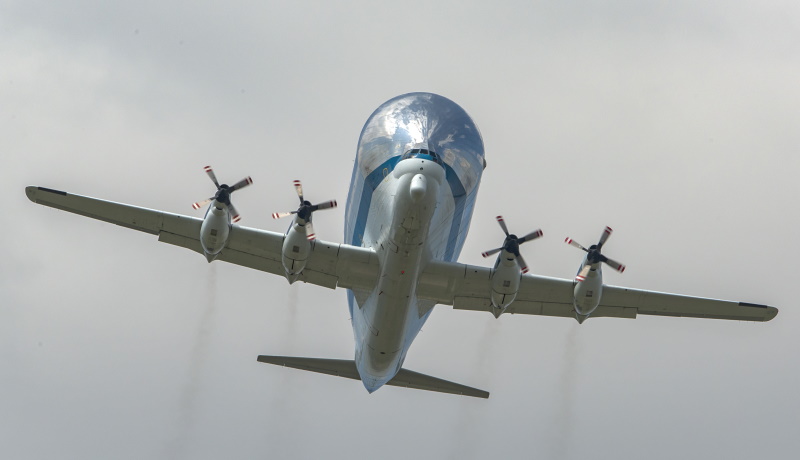
The Pregnant Guppy and Mini Guppy were sold off to other companies in the 1970s, with the Pregnant Guppy being scrapped in 1979, and the Mini Guppy parked at an air museum. The original Super Guppy and three of the Guppy 201s were also put out to pasture -- but at last notice, NASA was still flying its Guppy 201, on occasion leasing it out to other operators.
BACK_TO_TOP* B-29 production variants included:
* B-29 conversions included:
* B-50 production variants included:
* B-50 conversions included:
* C-97 production variants included:
* C-97 conversions included:
* Sources include:
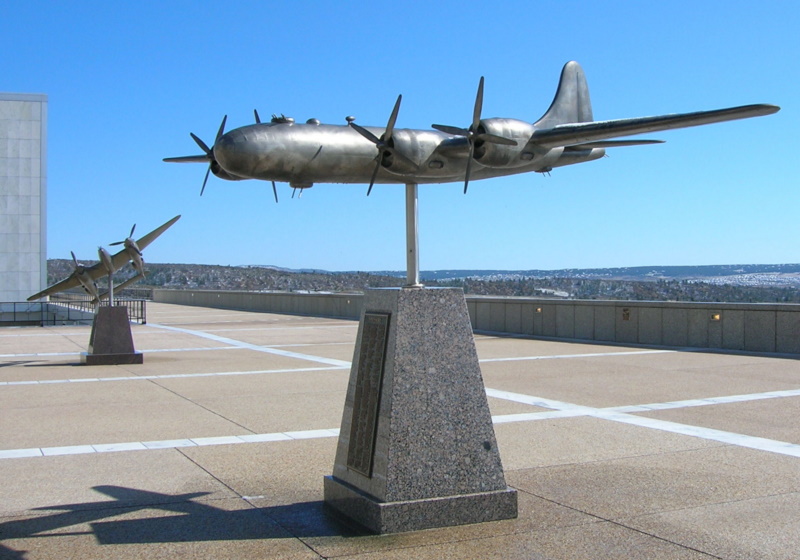
* Illustrations credits:
* Revision history:
v1.0.0 / 01 dec 19 v1.0.1 / 01 nov 21 / Review & polish. v1.1.0 / 01 may 22 / Review & polish. v1.1.1 / 01 apr 24 / Review & polish.BACK_TO_TOP
